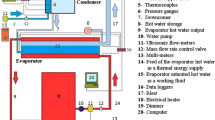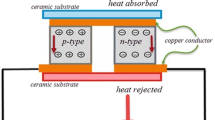Abstract
The two-phase loop thermosiphon is widely used in chip cooling combined with a fan and vibrates under the influence of the fan. In order to analyze the influence of vibration on the heat transfer characteristics, two-phase loop thermosiphons with a vibration frequency of 40 Hz and a vibration acceleration of 20 m·s−2 were studied experimentally. The obtained results show that vibration does not change the change trend of temperature distribution and thermal resistance of a two-phase loop thermosiphon. However, vibration affects the heat transfer performance of the two-phase loop thermosiphon and the influence is affected by the coupling effect of the liquid filling rate. Also, vibration shortens the starting-up time of the two-phase loop thermosiphon and restrains the superheat of the evaporation section during starting-up processes.







Similar content being viewed by others
Abbreviations
- T:
-
Temperature (℃)
- FR:
-
Filling ratio (%)
- H:
-
Height (m)
- Q:
-
Effective heating power(W)
- P:
-
Heating power (W)
- R:
-
Thermal resistance (℃·W−1)
- C:
-
Specific heat capacity(J·g−1·℃−1)
- \(\dot{m}\) :
-
Mass flow rate(g·min−1)
- c, cond:
-
Condensing section
- e, evap:
-
Evaporation section
- in:
-
Inlet
- out:
-
Outlet
- s:
-
Static
- v:
-
Vibration
References
Wang WW, Cai Y, Wang L et al (2020) Thermo-hydrodynamic analytical model, numerical solution and experimental validation of a radial heat pipe with internally finned condenser applied for building heat recovery units. Energy Convers Manag 219:113041.1–113041.13. https://doi.org/10.1016/j.enconman.2020.113041
Bondarenko BI, Moraru VN, Kravets VYu et al (2019) The Effect of Nanofluids on the Heat-Transfer Capacity of Miniature Thermosyphons for Electronics Cooling. Tech Phys Lett 45(3):299–303. https://doi.org/10.1134/S1063785019030234
Zhang T, Yan ZW, Wang LY et al (2020) Comparative study on the annual performance between loop thermosyphon solar water heating system and conventional solar water heating system. Sol Energy 197:433–442. https://doi.org/10.1016/j.solener.2020.01.019
Oliveira JLG, Tecchio C, Paiva KV, MBH et al (2016) In-flight testing of loop thermosyphons for aircraft cooling. Appl Therm Eng 98144–156. https://doi.org/10.1016/j.applthermaleng.2015.12.008
Oliveira JLG, Tecchio C, Paiva KV, MBH et al (2015) Passive aircraft cooling systems for variable thermal conditions. Appl Therm Eng 7988–97. https://doi.org/10.1016/j.applthermaleng.2015.01.021
Prisniakov K, Marchenko O, Yu Melikaev V et al (2004) About the complex influence of vibrations and gravitational fields on serviceability of heat pipes in composition of space-rocket systems. Acta Astronautica 55(3/9):509–518. https://doi.org/10.1016/j.actaastro.2004.05.005
Zhang MY, Zhen QH, Jia LL et al (2020) Experimental Investigation on Geyser Boiling of Two-Phase Closed Thermosyphon with Different Diameters. J Eng Therm Energy Power 35(10):110–116. https://doi.org/10.1007/s00231-015-1746-5
Elkholy A, Kempers R (2020) Experimental investigation of geyser boiling in a small diameter two-phase loop thermosyphon. Exp Therm Fluid Sci 118. https://doi.org/10.1016/j.expthermflusci.2020.110170
Ding T, Cao HW, Guang Z et al (2020) Experimental study on a loop thermosyphon cooling system in data centers using CO2 as a working Fluid, especially thermal environment and energy-saving effect. Appl Therm Eng 175. https://doi.org/10.1016/j.applthermaleng.2020.115359
Zhang T, Pei G, Zhu QZ et al (2016) Investigation on the Optimum Volume-Filling Ratio of a Loop Thermosyphon Solar Water-Heating System. J Sol Energy Eng 138(4). https://doi.org/10.1115/1.4033403
Soleymaniha M, Ahmad A, Shanbedi M et al (2018) Water-based graphene quantum dots dispersion as a high-performance long-term stable nanofluid for two-phased closed thermosyphons. Int Commun Heat Mass Transf 95:147–154. https://doi.org/10.1016/j.icheatmasstransfer.2018.05.009
Liu WJ, Yang ZQ, Zhang B et al (2017) Experimental study on the effects of mechanical vibration on the heat transfer characteristics of tubular laminar flow. Int J Heat Mass Transf 115:169–179. https://doi.org/10.1016/j.ijheatmasstransfer.2017.07.025
Zhang DW, Jiang EH, Zhou JJ et al (2020) Investigation on enhanced mechanism of heat transfer assisted by ultrasonic vibration. Int Commun Heat Mass Transf115. https://doi.org/10.1016/j.icheatmasstransfer.2020.104523
Mitsuishi A, Takahashi M, Shimura T et al (2021) Effect of spatial development on convective heat transfer enhancement in a pipe with transverse vibration. J Therm Sci Technol 16(1). https://doi.org/10.1299/jtst.2021jtst0002
Setareh M, Saffar M, Abdullah A et al (2019) Experimental and numerical study on heat transfer enhancement using ultrasonic vibration in a double-pipe heat exchanger. Appl Therm Eng 159:113867. https://doi.org/10.1016/j.applthermaleng.2019.113867
Chang TB, Wang ZL (2016) Experimental investigation into effects of ultrasonic vibration on pool boiling heat transfer performance of horizontal low-finned U-tube in TiO2/R141b nanofluid. Heat Mass Transf 52(11):2381–2390. https://doi.org/10.1007/s00231-015-1746-5
Amir A, Morteza HK, Shahab KR (2013) A vertical heat pipe: an experimental and statistical study of the thermal performance in the presence of low-frequency vibrations. Heat Mass Transf 49:285–290. https://doi.org/10.1007/s00231-012-1057-z
Chen RH, Kuo L, Lai CM (2015) The influence of longitudinal vibrations on the heat transfer performance of inclined heat pipes. Adv Mech Eng 7(2):1–13. https://doi.org/10.1177/168781401556894
Li FJ, Gao JM, Shi XJ (2018) Experimental investigation of an R600a two-phase loop thermosiphon to cool a motorized spindle shaft. Int Commun Heat Mass Transfer 97:9–16. https://doi.org/10.1016/j.icheatmasstransfer.2018.06.005
Coleman HW, Steele WG (1991) experimentation validation and uncertainty analysis for engineers. J Eng Ind 113(2):343–344. https://doi.org/10.1115/1.2899692
Acknowledgements
The financial support of Guangdong Basic and Applied Basic Research Foundation (No. 2020A1515111099, No.2019A1515110304) is gratefully acknowledged.
Author information
Authors and Affiliations
Corresponding author
Ethics declarations
Conflict of interest
On behalf of all authors, the corresponding author states that there is no conflict of interest.
Additional information
Publisher's Note
Springer Nature remains neutral with regard to jurisdictional claims in published maps and institutional affiliations.
Highlights
• Two-Phase Loop Thermosiphons (TPLTs) are studied in vibrational state.
• The influence of vibration on heat transfer performance of TPLTs is analyzed.
• The effect of vibration on the start-up process is investigated.
Rights and permissions
Springer Nature or its licensor holds exclusive rights to this article under a publishing agreement with the author(s) or other rightsholder(s); author self-archiving of the accepted manuscript version of this article is solely governed by the terms of such publishing agreement and applicable law.
About this article
Cite this article
Wang, Z., Huang, Y., Gong, T. et al. Experimental investigation of the heat transfer characteristics of a vibrational two-phase loop thermosiphon. Heat Mass Transfer 59, 817–824 (2023). https://doi.org/10.1007/s00231-022-03290-3
Received:
Accepted:
Published:
Issue Date:
DOI: https://doi.org/10.1007/s00231-022-03290-3




